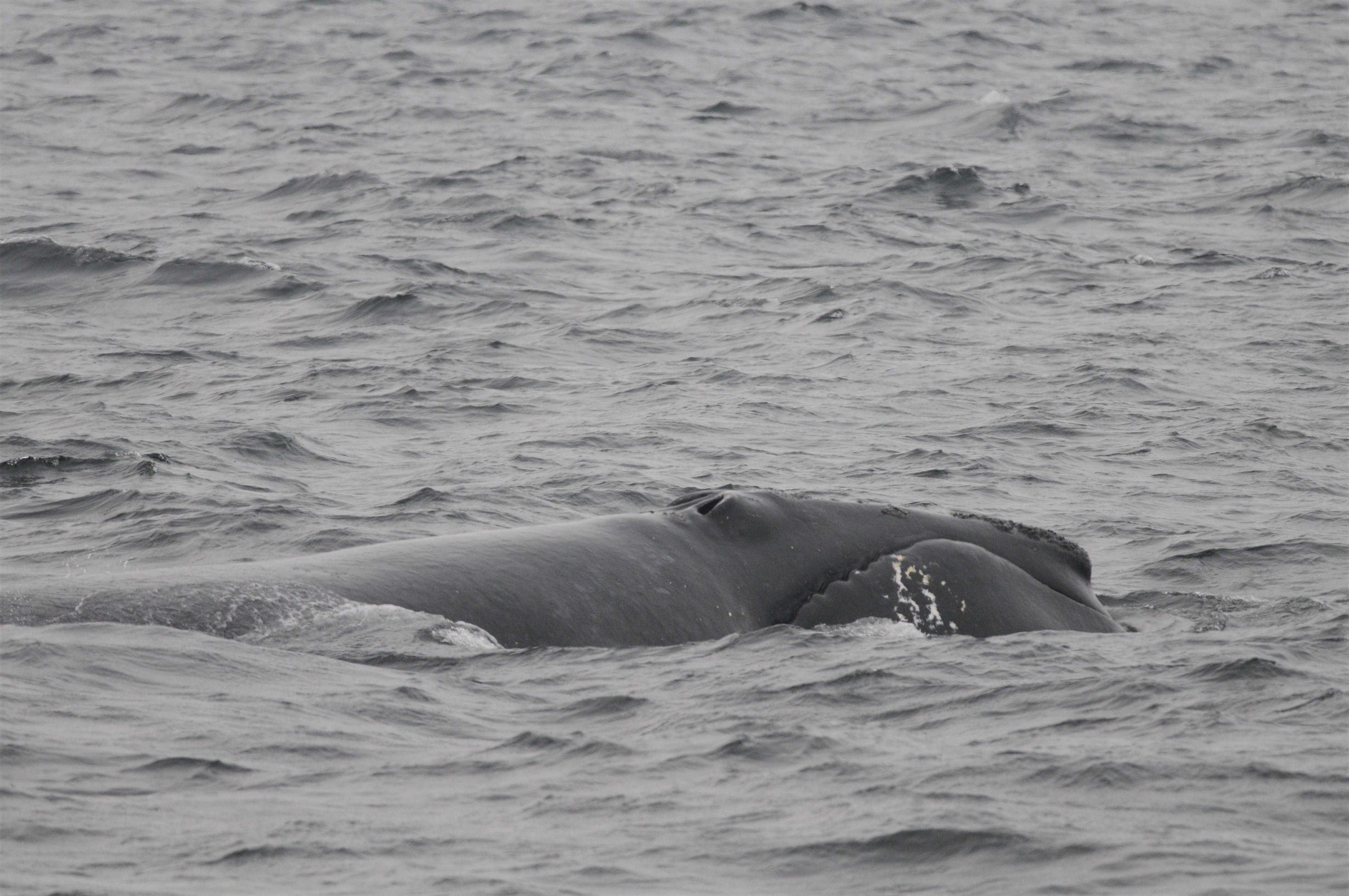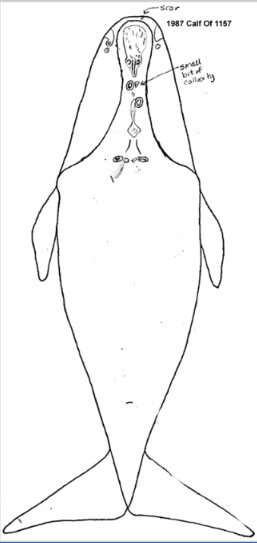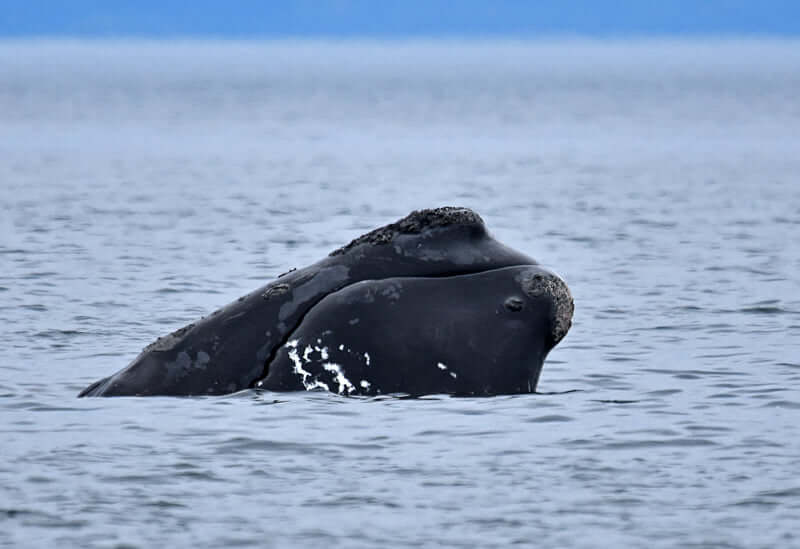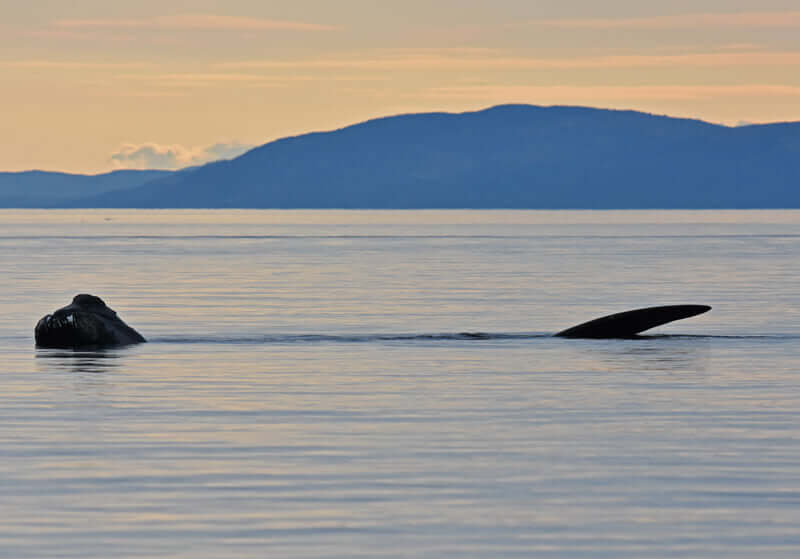Wolf (#1703)
North Atlantic Right Whale


-
ID number
1703
-
Sex
Female
-
Year of birth
1987
-
Known Since
1987
Distinctive traits
North Atlantic right whales can be identified by natural markings: calluses on the head and the lips of the animal. Each individual has a unique pattern, similar to a human fingerprint.
Secondary markings such as scars can also contribute to identification.
Wolf can be identified by the very discontinuous callus line on the head. She also has a scar on the front of the lower lip.
She was named “Wolf” because her coaming looks like a chain of islands and the Wolves are a group of islands in the Bay of Fundy.
Life history
Wolf was first observed in September 1987 in the Bay of Fundy. She was only a calf then, and was swimming with her mother, Moon (#1157). She is believed to be at least Moon’s third calf.
Thanks to a sample taken from Wolf, we know her sex (she is a female). Genetic analysis also revealed that her father is the North Atlantic right whale identified as #1516 in the photo-identification catalog of the species.
Wolf is one of the last 400 representatives of her species. She is all the more precious as she is of reproductive age — there are only about 100 reproductive females left in the population. She is the mother of, at least, four calves, born in 2001, 2005, 2008 and 2015. To date, none of her calves have calved, so she is not a grand-mother yet.
Over the years, Wolf has been observed many times, and the observations were recorded in the catalog managed by the New England Aquarium. In winter, she is mainly seen off Florida and Georgia and in summer in the Bay of Fundy. In spring, she is frequently identified in Cape Cod Bay. Like all North Atlantic right whales, Wolf migrates annually along the Canadian and U.S. coasts. This migration in highly urbanized areas is particularly perilous for right whales, which are all too often victims of collisions and entanglement.
In recent years, changes in North Atlantic right whale migrations have been observed. Recently, Wolf has been found several summers in the Gulf of St. Lawrence. In September 2020, she was even spotted in the Saguenay—St. Lawrence Marine Park, an area outside of the usual range of the species! At least one other right whale — unidentified — also came to visit the Estuary that summer during the same period. The last confirmed sighting of this species so high in the Estuary was in 2016.
Wolf was observed and photographed in the estuary for 11 days in a row, before being seen swimming towards the gulf… probably to begin her return to the warm southern waters.
Observations history in the Estuary
Years in which the animal was not observed Years in which the animal was observed
Dernières nouvelles
On their way
The North Atlantic right whale “Wolf” has not been seen in the area since Monday, October 5. After 11 days exploring the waters of the Saguenay-St. Lawrence Marine Park and having her photo taken from every angle like a rock star, she seems to have found her way home. During the most recent reported sighting, it was heading east-northeast at a brisk pace, diving for just a few minutes at a time and vigorously slapping its pectorals fins on the surface. We hope to hear from her again soon!
North Atlantic right whales are the focus of very rigorous scientific monitoring along the US coasts. Consequently, we know that Wolf is accustomed to basking in the Florida or Georgia sun during the winter months. Will she be back to visit us next year?
Note: The North Atlantic right whale named Wolf was observed 11 days in a row between Tadoussac and Les Escoumins, before disappearing, probably on its way back to the Gulf. The presence of at least a second right whale was confirmed during this period in the same area.
Black: colour of hope
This past week in the St. Lawrence Estuary, it was a funny-looking rounded black back with a V-shaped breath that caught everyone’s eye and created a great deal of excitement. A North Atlantic right whale! One of the last 400 representatives of its species, and a rare visitor to the Estuary… the most recent visit was back in 2016!
It all began on September 23 and 24, when photographer Renaud Pintiaux spotted this unusual visitor, but was unable to get a picture. On September 25, he observed two right whales a few kilometres apart off Cap de Bon-Désir, and finally managed to photograph one of them. “The first one I saw looked smaller and was diving for long stretches. That day she was heading east, so perhaps she left the area. The larger of the two individuals, which was taking shorter dives, I was able to photograph on five consecutive days,” he points out.
Thanks to his photos and the New England Aquarium catalogue, the right whale has been identified: it is Wolf (#1703), a 33-year-old adult female and the daughter of Moon (#1157). From that point on, it’s pure bliss: “So, did you see her?” “Unbelievable, it’s a dream come true”, “I cried when I saw her yesterday.” “The encounter of a lifetime!”, “I’ve been waiting for years to see one!” Each witness describes their precious encounter with Wolf as a gift. On September 29, the whale is off Tadoussac, near the Batture aux Alouettes tidal flats. Hearing the news, one resident near the dunes steps out of her house and spots the animal in the distance. “I never thought I would see one from my own backyard!”, she says, visibly moved.
But the presence of a North Atlantic right whale also creates tension for the shipping sector. This critically endangered species is especially vulnerable to entanglements and collisions with watercraft. Plump and not particularly reactive, the species spends a lot of time on the surface and in shallow areas. On account of its presence, ship operators are encouraged to slow down and be extra cautious. To limit disturbance, observation boats must maintain a minimum distance of 400 m.




